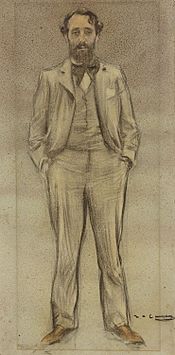Enric Clarasó facts for kids
Quick facts for kids
Enric Clarasó
|
|
|---|---|

Enric Clarasó, by Ramon Casas
(date unknown) |
|
| Born |
Enric Clarasó i Daudí
14 September 1857 Sant Feliu de Racó
|
| Died | 1941 Barcelona
|
| Resting place | Sant Gervasi Cemetery, Barcelona |
| Occupation | modernist Catalan sculptor |
| Organization | Cercle Artístic de Sant Lluc |
|
Notable work
|
Equestrian statue of James I of Aragon in Palma |
Enric Clarasó i Daudí (born September 14, 1857, in Sant Feliu del Racó, near Barcelona – died 1941, in Barcelona) was an important Catalan sculptor. He was known for his art during the Modernist movement, a style popular in the late 1800s and early 1900s.
Contents
Enric's Early Life and Art Journey
Enric Clarasó was born into a family of skilled craftspeople. When he was just two years old, his family moved to Barcelona. There, he started working as an apprentice in a perfume shop.
After getting sick with yellow fever in 1869, he found a new job. He began working in the studio of a sculptor named Joan Roig i Solé. While working there, Enric also studied drawing and how to model with clay at the Escola de la Llotja, a famous art school.
In 1880, he opened his first art studio with his friend, the painter Miquel Carbonell. When Carbonell moved away, Enric worked in several different places. One of these places was a studio he briefly shared with Santiago Rusiñol. This studio later became the Cau Ferrat Museum, a well-known art museum.
First Exhibitions and New Ideas
During this time, Enric had his first art show at the Sala Parés, a famous art gallery. He also helped decorate the Teatre Principal, a theater in Barcelona.
He showed some of his smaller artworks at the 1888 Barcelona Universal Exposition, a big world fair. He also took a short trip to Paris, France. In Paris, he learned about new art styles and ideas. He went back to Paris in 1890 and studied at the Académie Julian, a famous art school, with a teacher named Henri Chapu.
After returning to Barcelona, Enric started showing his art in many different exhibitions. This included the World's Columbian Exposition in Chicago, USA. It was during this time that his art started to show signs of the Modernist style.
Later Works and Public Art
Around the same time, Enric became a very religious person. This change was seen in his artworks. It happened after his father passed away and after he married Pilar Serrat in 1896, who was also very religious.
Soon after, he didn't get a job to create a memorial in Seville. However, he did get a job to create a group of sculptures for the Palace of Justice in Pamplona. He also joined the Cercle Artístic de Sant Lluc, an art group known for its strong Catholic beliefs. By 1904, he was successful enough to build his own home in Sarrià, which he called "La Torre de Sant Francesc."
Big Projects and Final Years
For the next thirty years, Enric mostly stopped making small art pieces. Instead, he focused on creating large sculptures for public spaces and religious groups. One of his most famous works from this time is a statue of James I of Aragon riding a horse in Palma. You can also see many of his sculptures at the Montjuïc Cemetery in Barcelona.
In 1932, he built a large art studio next to his home. But the next year, he stopped taking new jobs for public art and stopped showing his work in exhibitions. He spent his time writing his life story, which was published in 1934.
He stopped working completely a few years later, near the end of the Spanish Civil War. During this time, some people broke into his studio and destroyed the statues of saints he had there. Enric Clarasó was buried next to his father in the Sant Gervasi Cemetery in Barcelona.
Images for kids
-
Memento Homo at Montjuïc Cemetery
See also
 In Spanish: Enric Clarasó para niños
In Spanish: Enric Clarasó para niños



